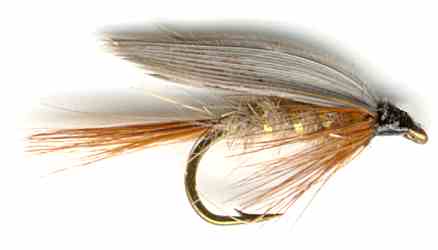The Gold Ribbed Hare's Ear Wet Fly
The Gold Ribbed Hare's Ear wet fly is used to imitate emerging crippled mayfly and caddis, spent spinners and exhausted egg laying females.

WET FLY PATTERNS. Hook size 12 14 - $US each
Gold Ribbed Hare's Ear Wet Fly
I know it seems strange to be writing about Fredrick M Halford, the famous Victorian dry fly purist, in the same article that covers the more famous Gold Ribbed Hares Ear Nymph and wet fly. Halford knew of the excellent qualities of the fly’s design; how the scruffy fibres of the hare’s ear fur imitated the movement of insect legs which resulted in takes. He would have used the fly in his early youth when fishing on the chalk fed river Wandle in Hackbridge, South West London. It must have been a difficult decision for him to admit that nymphs caught trout but he got over it by using a dry fly that incorporated the features of the GRHE but also had upright feather wings and a stiff cock-hackle.
During the later period of his life, F.M.Halford regarded wet flies and nymphs not far removed from maggots. His belief was that the pure art of fly fishing was from using dry flies only. Any other type of fishing was second class and not for gentlemen. I do not believe his views were this black and white. He was aware of the virtues of nymph and wet fly fishing. He just loved dry fly fishing and wrote about his niche interest. I feel his concentration on this aspect of fly fishing has been seriously overstated by his disciples.
The dry fly version of the Gold Ribbed Hares Ear nymph does catch fish but not as many as the nymph and wet fly versions of the same pattern. The main reason is that they can be fished at any time during the fishing season unlike the dry fly that only works well during a hatch or spinner fall when the trout are actively looking up at what is floating on the water surface.
There are times when trout get locked on a particular type of food source. This happens when there is a sudden abundance, for example during a hatch of a particular type of insect or during a spinner fall. Trout take 80% of their food from under the water. This also applies during a hatch contrary to popular belief. Many emerging mayflies and caddis fail to break free from their nymphal skin and drown; these are called cripples. Some are blown over by a gust of wind and cannot free themselves from the surface film and die. Others are just swamped if the hatch occurs in rough water conditions. When mayfly spinners or exhausted egg laying caddis females collapse onto the water surface they become fish food. The lurking trout are always on the look out for easy targets that are just drifting in the water current. This is when the Gold Ribbed Hare’s Ear wet fly can be deployed. It should be fished just under the surface on a drag free dead drift. Trout will be positioned in areas of calmer water where they can watch for food drifting past them. They let the food come to them rather than expend energy actively hunting for it.
Once you have located suitable trout lying-up locations try to cast upstream and let your fly drift past them. Do not allow your line to go tight. The fish expect to see their dead food drift past them not suddenly come back to life and try to swim against the current. If that happened they will get spooked and swim away. Use a strike indicator or tie your wet fly onto a surface floating dry fly

